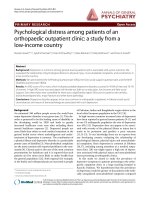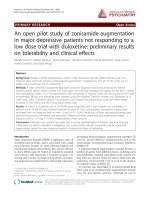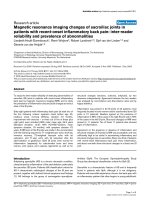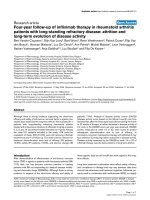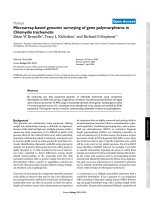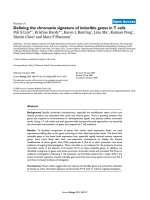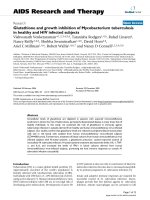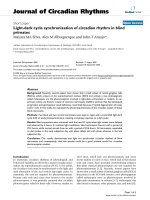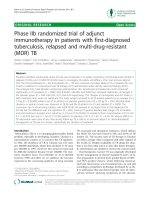Báo cáo y học: " Depression literacy among Australians of Chinese-speaking background in Melbourne, Australia" ppt
Bạn đang xem bản rút gọn của tài liệu. Xem và tải ngay bản đầy đủ của tài liệu tại đây (243.24 KB, 10 trang )
RESEARC H ARTIC LE Open Access
Depression literacy among Australians of
Chinese-speaking background in Melbourne,
Australia
Fu Keung Daniel Wong
1*
, Yuk Kit Angus Lam
2
, Ada Poon
3
Abstract
Background: This study investigated the knowledge of depression and preference for professional help,
medications and treatment methods among Australians of Chinese-speaking background, and the perceptions of
this population of the causes of mental illness.
Methods: Adopting a cluster convenience sampling method, the study recruited 200 Chinese-speaking subjects from
four major areas in metropolitan Melbourne where many Chinese live. The respondents were presented with a vignette
describing an individual with depression and then asked questions to assess their understanding of depression and
preference for professional help, medications and treatment methods. A comparative approach was used to compare
the findings with those of a previous study of the mental health literacy of Australian and Japanese adults.
Results: Compared to the Australian and Japanese samples, a much lower percentage of Chinese-speaking
Australians (14%) could correctly identify major depression described in the vignette, and a higher percentage
believed that counseling professionals could be helpful. Higher percentages of those who believed that close
family members could be helpful were found in the Chinese-speaking Australian and Japanese samples, and these
two groups also expressed more uncertainty about the usefulness or harmfulness of certain medications compared
to the Australian sample. Higher percentages of respondents in both the Chinese-speaking Australian and the
Australian sample considered “lifestyle changes” to be helpful compared to the Japanese sample. In the Chinese-
speaking sample, 30%, 17.4%, 33% and 27% of the respondents rated “ traditional Chinese medicine doctors,”
“Chinese herbal medications,”“taking Chinese nutritional foods/supplements” and “qiqong“ as helpful. Many
perceived “changing fungshui“ and “traditional Chinese worship” to be harmful. Regarding the perception of causes
of mental illness, items related to psychos ocial perspectives including “life stress” and “interpersonal conflict” were
rated highly by the respondents, whereas traditional beliefs including “punishment for misdeeds conducted by
ancestors” and “demon possession” had the lowest ratings.
Conclusions: Campaigns to increase the mental health literacy of Chinese-speaking Australians are needed. The
abovementioned socially and culturally driven beliefs need to be taken into consideration in the development of
culturally relevant education programs.
Background
Australia is a culturally diverse nation - 43% of Austra-
lians were born overseas or have at least one parent
who was born overseas [1]. Besides English, the most
commonly spoken languages in the country are Italian,
Greek, Cantonese, Arabic, Vietnamese and Mandarin.
The latest census shows that there are 206,590, 71,800,
24,370 and 39,970 China-born, Hong Kong-born, Tai-
wan-born and Singapore-born Chinese, respectively,
who live in Australia [1]. People of Chinese- speaking
background make up 3.4% (669,000) of the total Austra-
lian population. Overseas and Australian scholars have
found that Asians, including Chinese, have a low rate of
utilization of mental health services [2,3]. Underutiliza-
tion is likely the result of a combination of personal,
sociocultural and societal factors that influence whether
* Correspondence:
1
School of Nursing and Social Work, Faculty of Medicine, Dentistry and
Health Sciences, University of Melbourne, Level 5, 234 Queensberry Street,
Carlton, Melbourne, Victoria, 3053, Australia
Wong et al. BMC Psychiatry 2010, 10:7
/>© 2010 Wong et al; licensee BioMed Central Ltd. This is an Open A ccess article distributed under the terms of the Cr eative Commons
Attribution License (h ttp://creativecommons.org/licenses/by/2.0), which permits unrestricted use, distribu tion, and reproduction in
any medium, provided the original work is properly cited.
or not people of culturally and linguistical ly diverse
backgrounds seek help from mental health services.
Knowledge of and beliefs surrounding mental illness
and available mental health services [4,5], cultural con-
ceptions of the causes of mental illness [6,7], public and
self-stigma [8,9], the tendency to rely on informal net-
works for support [10], and practical difficulties in
accessing services have been mentioned in the literature
to be associated with delays in accessing mental health
services [11].
Mental health literacy refers to “knowledge and beliefs
about mental disorders which aid their recognition,
management or prevention” [12]. Inherent in this con-
cept is the assumption that individuals who have a
higher level of mental health literacy will be more will-
ing to seek professional help for themselves and/or for
people whom they know may be suffering from a mental
health problem. Jorm et al. conducted pioneer research
[5,12] into the mental health literacy of Australians. In
one of their studies [5], they found that over 67% of the
910 Australian respondents were able to correctly iden-
tify major depression described in a case vignette, and
that the percentages of those who considered a family
doctor/GP or counselor, antidepressants, or physical
activity helpful for treating depression were 80%, 48%
and 92%, respectively. In a Canadian study conducted
by Wang et al. [13] using the same depression vignette,
higher percentages of respondents correctly labeled the
person in the vignette as suffering from depression
(75.6%), considered a family doctor/GP or counselor to
be helpful (89.7% and 89.3%, respectively), and said tak-
ing antidepressants or engaging in physical activities was
helpful (62% and 96.5%, respectively). However, in gen-
eral the mental health literacy of the Australian and
Canadian samples was comparable.
Several studies have explored the mental health lit-
eracy of Chinese-speaking people. A study of the under-
standing of depression among Chinese-American
women reported that 58% of the respondents believed
that the person in the vignette suffered from a psycholo-
gical disturbance, and only 13% failed to label the per-
son’s condition as depression [14]. In studies conducted
by Parker and colleagues of Chinese-speaking Austra-
lians, the resea rchers found that (1) Chinese people
tended to deny depression or express it somatically [15];
(2) Chinese were less likely to view a depressive episode
as a disorder or to seek help for a psychological problem
[16]; (3) most Chinese confided what they perceived to
be private matters only to family members or close
friends [17] and (4) many Chinese expected Western
medications to provide an instant cure to all kinds of
worries, without need for explanation as to how such
drugs work [17]. In addition, respondents obtained
knowledge about medications more often from friends
and family than from medical professiona ls, and seldom
asked their doctors questions about the drug they were
prescribed because to do so would challenge their
“authority” [17]. In a qualitative study of Chinese-speak-
ing Australians conducted by Blignault, Ponzio, Rong
and Eisenbruch [18], knowledge of mental illness, lan-
guage barriers, stigma, confidentiality concerns, service
constraints and discrimination were mentioned by the
participants as major barriers affecting access to mental
health services. These studies have provided us with
information about the perceptions of the causes of men-
tal illness and help-seeking behaviors of Chinese-speak-
ing Australians. However, to the best of these authors’
knowledge, there was only one study that had attempted
to systematically explore the nature and level of mental
health literacy among Chinese-speaking people.
This study was conducted by Klimidis, Hsiao and
Minas which reported that 51% of Chinese-speaking
Australians were able to recognize major depression
described in a vignette, that multiple labels were used
by the respondents, and that 49% and 73.6% of them
said that the condition was related to emotional/mental
problems and stress, respectively [19]. The authors com-
pared their findings with those of an early study of Jorm
and colleagues [4] and concluded that Chinese-speaking
Australians did not appear to have a low level of mental
health literacy. Their conclusion, however, warrants
further validation because the two studies did not use
the same vignette and response format to solicit the opi-
nions of the two groups of respondents. In addition, the
studies of Ying [14] and Klimidis [19] did not use a cul-
tural perspective to explore the variation in the prefer-
ence for the type of professional help, medication and
treatment method or the conception of mental illness
among Chinese-sp eaking people. Such an understanding
would enable the design of culturally relevant public
education programs to enhance the mental health lit-
eracy of people of Chinese-speaking background in Aus-
tralia and other countries. In this study, we used the
same depression vignette and response format proposed
by Jorm et al. [20] and compared our findings with
those of Jorm et al. [20] of the mental health literacy of
Australian and Japanese people. We chose these two
samples for comparison based on the notion that a
comparison with the Australian sample might elucidate
possible cultural differences in the preference for profes-
sional help, medications and treatments between Austra-
lians and Chinese-speaking Australians. On the other
hand, a comparison with the Japanese sample (who are
presumed to be culturally more similar to the Chinese-
speaking Australians) might illuminate socioeconomic
and policy differences in the preference for professional
help, medications and treatments between people in
these two countries. Lastly, to explore the c ultural
Wong et al. BMC Psychiatry 2010, 10:7
/>Page 2 of 10
dimension of the mental health literacy of Chinese-
speaking Australians, we added a number of culturally
relevant options under the professional help, medication
and other treatment categories in the questionnaire.
The adoption of a certain explanatory model of the
causes of mental illness affects not only a person’ s
understanding of mental illness but also his or her
choice of medication and treatme nt [20,21]. It is there-
fore important to explore the cultural conception of
mental illness as it is highly related to the mental health
literacy of cultural groups. A study conducted by Tang
et al. [22] in China found that patients who believed
that they had a physical rather than a mental illness
tended to seek help from qigong masters or folk healers.
Studies conducted by Phillips et al. in China [6] and
Wong et al. in Hong Kong [7] revealed that respondents
highly endorsed psychosocial explanatory models such
as stress, interpersonal conflict and personality deficits
in explaining the causes of mental illness. There are,
however, very few studies of the cultural conception of
mental illness of Chinese-speaking Australians. Among
them, Hsiao et al. [21] conducted qualitative research
and found that this population combined traditional
with Western medical knowledge to develop their own
labels for various kinds of mental disorders, which
included “mental illness,”“physical illness,”“normal pro-
blems of living” and “ psychological problems.” Parker
and colleagues found that Chinese people t ended to
deny depression or express it somatically and did not
view a depressive episode as a disorder [15-17].
Objectives
(1) To understand the mental health literacy of
Chinese-speaking Australians in Melbourne, Australia.
(2) To explore the preference for culturally specific
professional help, medications and treatment meth-
ods among Chinese-speaking Australians.
(3) To understand the conception of the causes of
mental illness of Chinese-speaking Australians.
Methods
Sample
This study adopted a cluster convenience sampling
method in which subjects were taken from four major
areas in metropolitan Melbourne where many Canto-
nese- and Putongua/Mandarin-speaking Chinese peop le
live: Box Hill, Doncaster, Monash and Preston. The par-
ticipants were recruited through social services organiza-
tions serving the Chinese population in these four areas.
Posters in both traditional and simplified Chinese intr o-
ducing the research were put up on the exhibition
boards of these organizations. Potential participants who
were interested in the study then approa ched the
research team for further details. Those who decided to
participate in the survey signed a consent form and
were then given the questionnaire for completion. Selec-
tion criteria included: (1) aged 18 or above, and (2)
immigrants of Chinese-speaking background who were
living in Melbourne, Australia. Respondents took about
40 minutes to complete the questionnaire. The study
was approved by the Ethics Committee of the University
of Melbourne.
Survey questionnaire
This instrument covered three areas: sociodemographic
characteristics of the respondents, mental health literacy
(depression vignette), and Chinese conception of the
causes of mental illness.
Mental health literacy
This instrument was adapted fro m that used by Jorm et
al. [4] to investigate mental health literacy among Aus-
tralian samples. The original instrument incl udes
depression and schizophrenia vignettes. In this study,
only the vignette describing a person with major depres-
sion was used [20]. The depression vignette was written
to satisfy the diagnostic criteria for major depression
according to the fourth edition o f the Diagnostic and
Statistical Manual of Mental Disorders (DSM-IV) and
tenth revision of the International Statistical Classifica-
tion of Diseases and Related Health Problems (ICD-10).
After reading the vignette, respondents answer a series
of questions that assess their recognition of the disorder,
awareness of m ental illness, and beliefs about the help-
fulness or harmfulness of different professions, medica-
tions and treatment methods. In the first section of this
questionnaire, after the depression vignette, respondents
are asked to provide written answers to two questions:
“Do you think the person needs help or not?” (yes/no
format) and “ What do you think is wrong with the per-
son?” The main part of the questionnaire is divided into
three sections. Respondents are asked to rate each type
of (1) professional, (2) medication and ( 3) treatment as
“Helpful,”“Harmful” or “ Not Sure” in relation to the
mental health issue faced by the person in the depres-
sion vignette. Based on a literature review [10,23,24] and
our clinical experience in working with Chinese people,
we added items to the list of options to explore the cul-
tural dimension of the beliefs of respondents about pro-
fessional help, medications and t reatment methods. For
example, under Professional Help, “traditional Chinese
medicine doctor” and “traditional healer” were added;
under Medications, “ Chinese herbal medicine"; and
under Treatment Methods, “taking Chinese nutritional
foods/supplements,”“qiqong,”“changing fungshui” and
“traditional Chinese worship.” The English version of
the scale was translated into Chinese and back trans-
lated into English by an experienced professional trans-
lator. Both traditional and simplified Chinese versions of
the questionnaire were available for the respondents.
Wong et al. BMC Psychiatry 2010, 10:7
/>Page 3 of 10
Chinese conception of the causation of mental illness
This scale measures the degree to which a respondent
agrees or disagrees with different perspectives about the
causation of mental illness: hereditary, biochemical, per-
sonal, environmental and cultural. It was adapted from
that used in a study conducted by Wong et al. [7].
There are 23 items in the original scale, which are
divided into two categories: causes of mental illness
(e.g. , bad fungshui), and the treatment methods asso-
ciated with the causes of mental illness (e.g., rearranging
the household furniture to avoid bad fungshui). How-
ever, following a r eview of the questionnaire conducted
byapanelofthreecommunity mental health workers
who had been working with Chinese people with mental
illness, we decided to retain the 13 items that are related
to the causes of mental illness and discard those on
treatment methods because the latter items overlapped
with some in the mental health literacy scale. Items on
the causation scale were rated using a 5-point Likert
scale ("Absolutely unrelated” (1), “Not related” (2),
“Neither related nor unrelated” (3), “Relat ed” (4), “Abso-
lutely related” (5)). The higher is the score, the greater
is the belief of the respondent that a certain perspective
is related to the causation of mental illness.
Results
Table 1 shows the demographic characteristics of the
sample. There were more females than males (69.5% vs.
30.5%, respectively). The majority of the respondents
were married, between 40 and 65 years of age, spoke
mainly Cantonese or Putonghua/Mandarin, and were
relatively well educated, having received senior second-
ary to tertiary education. Most of them had been born
in Hong Kong or China, and migrated to Australia, on
average, about 10 years previously. Fifty-six percent had
an individual income of less than AUD 20000, and 18%
had an income between AUD 20001 and AUD 40000; it
wasestimatedthattheweeklyincomeofindividual
respondents was around AUD 450. Among them, 41%
rated their English profi ciency as average, and over 46%
rated it as poor to very poor. A bout 40% of the respon-
dents had full- or part-time jobs, and 25% were unem-
ployed. The demographic characteristics of our sample
were comparable to those of the population of Chinese-
speaking Australians and immigrants described in the
Australian Census [1] in terms of place of origin, major
dialects spoken, length of time in Austra lia, average
annual income an d education level. However, in our
sample, the male to fem ale ratio was higher and there
were more unemployed people [1].
Table 2 shows that although many respondents
believed that the person in the vignette needed help,
fewer of them compared to those in the other samples
[20] identified the condition of the individual as major
depression. They were more likely to consider the per-
son to be suffering from stress or anxiety. The respon-
dents in this study also rated professional help as more
helpful and less harmful than did their Australian and
Japanese counterparts in the study of Jorm et al. [20],
and preferred counseling professionals to other profes-
sionals or lay helpers, except close family mem bers (see
Table 3). The respondents in our sample and the Japa-
nese one both believed close family members to be help-
ful. Interestingly, although 30% of the respondents in
our sample rated traditional Chinese medicine doctors
as helpfu l, only 2.7% rated traditional healers as helpful,
and 55% suggested the latter could be harmful (Table 3).
Table 4 shows that Chinese-speaking Australians were
more equivocal about the helpfulness or harmfulness of
certain medications on the list, especially sleeping pills,
antipsychotics and tranquilizers, than the respondents in
the study of Jorm et al. [20]. Higher percenta ges of
respondents in the Chinese-speaking Australian and
Japanese samples indicated that they were unsure about
the usefulness or harmfulness of certain medications
compared to the Australian sample . In addition, Austra-
lians generally rated medications as more harmful than
did either the Chinese-speaking Australians or Japanese.
Forty-one percent of Chinese-speaking Australians indi-
cated that antidepressants would be helpful to the per-
son in the vignette, compared to 34.8% and 46.7% of
Japanese and Australians, respectively. Lastly, 17.4% of
the respondents in the present study rated Chinese her-
bal medications as helpful. However, a similar percen-
tage thought that they could be harmful (Table 4).
Both our s ubjects and the Australians in the study of
Jorm et al. [20] highly endorsed the notion of lifestyle
changes (i.e., engage in physical activities, get out more,
learn to relax) as helpful for the person in the vignette
(Table 5). However, the percentag es in these areas were
lower among the Japanese sample. Psychotherapy was
also rated very highly by our respondents, more so than
that in either the Australian or the Japanese sample. In
our study, about 33% and 27% of the respondents con-
sidered consuming Chinese nutritional foods/supple-
ments and practicing qiqong, respectively, to be helpful,
whereas very few perceived changing fungshui or tradi-
tional Chinese worship to be helpful. About half of the
respondents indicated that traditional Chinese worship
was harmful (Table 5).
Table 6 documents the conceptions of the respon-
dents in this study of the causes of mental illness. Items
related to psychosocial perspective were rated highly,
including life stress, negative life experience and inter-
personal conflict. Personality factors including intro-
verted personality and “think too much” also received
high ratings. Traditional beliefs such as “punishment for
misdeeds conducted by ancestors” and “demon
Wong et al. BMC Psychiatry 2010, 10:7
/>Page 4 of 10
Table 1 Demographic characteristics of the respondents (N = 200)
Item N %
Gender Male 61 30.5
female 139 69.5
Age Mean age = 49.2 Range = 19 to 78 years old
Education Primary school 6 3
Secondary school 23 11.5
Senior secondary school 57 28.5
Diploma 48 24
Bachelor’s degree 38 19
Master’s degree or higher 12 6
Unknown 16 8
Living in Australia (months) Mean stay = 125 months Range = 1 to 456 months
Place of origin China 86 43
Hong Kong 64 32
Vietnam 13 6.5
Singapore/Malaysia 18 9
Taiwan 16 8
Other 3 1.5
Marital status Single 24 12
Married 132 66
Widow 13 3.5
Divorced 24 11
Cohabitating 7 7.5
Personal income per year 0-20000 112 56
20001-40000 36 18
40001-60000 17 8.5
60001-80000 9 4.5
over 80001 2 1
Unknown 24 12
Language Cantonese 136 68
Putonghua/Mandarin 52 26
Hakka 4 2
Chiu Chou 3 1.5
Other 5 2.5
English ability Very poor 30 15
Poor 63 31.5
Average 82 41
Good 18 9
Very good 7 3.5
Employment Full time 40 20
Part time 41 20.5
Seeking employment 37 18.5
Unemployed 50 25
Retired 9 4.5
Housewife 11 5.5
Unknown 12 6
Wong et al. BMC Psychiatry 2010, 10:7
/>Page 5 of 10
possession ” had the lowest ratings. The findings indicate
that the Chinese-speaking Australians in this sample
endorsed psychosocial rather than traditional perspec-
tives of the causes of mental illness.
Discussion
Lower percentage of depression literacy among Chinese-
speaking Australians
In this study, only 14% of the respondents were able to
correctly label the depression vignette, a figure that is
much lower than the 67.6% for the Australian sample
and slightly lower than the 22.6% observed in the Japa-
nese sample of Jorm et al. [20]. One reason for this rela-
tively low percentage may be related to the Chinese
conception of mental illness. In recent years, there is
growing evidence to suggest that Chinese people tend to
view mental illness as a reflection of one’s “inability to
deal with social stress,”“interpersonal conflict” or “per-
sonality deficits” [6,7]. Thus, it is not surprising to find
that there were so few Chinese-speaking Australians in
our sample who could correctly label the vignette as a
case of major depression; 34% said that the p erson in
the vignette suffered from stress/anxiety or an emotional
disturbance. Indeed, our findings on the conceptions of
Chinese-speaking Australians of the causes of mental ill-
ness support the abovementioned finding of other stu-
dies that Chinese-speaking Australians tend to adopt
psychosocial and biochemical rather than traditional
perspectives.
However, it is important to note that 44% of the
respondents did not give the depression vignette any
label, which might have deflated the percentage of the
correct identification of the condition. It is possible
that some of these respondents did know the answer,
but were unsure of what label to give to the vignette
and consequently chose not to give one. In the future,
an answering format other than an open-ended ques-
tion format may be needed to determine whether the
respondent can correctly label the depression vignette.
Table 2 Percentage of respondents giving labels to the depression vignette and seeing that the person needed help
Item Australian Japanese Chinese Australian
Label %% %
Depression 65.3 22.6 14 (n = 28)
Stress/anxiety 16.6 25 26.5 (n = 53)
Emotional disturbance 4.5 29.4 7.5 (n = 15)
Insomnia/lack of concentration NA NA 8 (n = 16)
No answer NA NA 44 (n = 88)
Needing help
Yes 90.6 (n = 181)
No 9.4 (n = 19)
Table 3 Percentage of respondents rating each type of professional as “helpful” or “harmful” for the person in the
depression vignette (by sample)
Item % %
Helpful Harmful
Australian Japanese Chinese Australian Australian Japanese Chinese Australian
1. Doctor 87.3 30.4 74 0.5 9.4 2.1
2. Pharmacist 35.4 6.8 27.6 8.7 23.6 8.6
3. Counselor 82.2 85.8 90.2 3.1 1.0 0.5
4. Social worker 62.8 73.4 86.9 4.5 1.4 1.0
5. Hot-line telephone counselor 63.5 42.4 77.4 5.9 8.6 1.1
6. Psychiatrist 65.0 69.4 73.5 7.1 5.4 3.7
7. Clinical psychologist 66.9 56.6 83.6 5.1 6.0 0
8. Close family members 67.9 85 82.2 4.9 1.6 2.1
9. Close friends 78.2 84.8 76.4 2.1 1.8 2.6
10. Naturopath 34.9 11.2 39.2 11.1 18.8 4.2
11. Religious practitioner 45.3 13.6 58.5 8.1 24.2 2.1
12. Deal with it alone 13.1 24.4 28.2 64 41.4 61.7
13. Traditional Chinese medicine doctor NA NA 31.8 NA NA 8.0
14. Traditional healer NA NA 2.7 NA NA 54.9
Wong et al. BMC Psychiatry 2010, 10:7
/>Page 6 of 10
Endorsement of a psychosocial perspective and its
influence on preferences for professional help,
medications and treatment methods
In this study, Chinese-speaking Australians tended to
rate counseling professionals (e.g., counselors, social
workers, hot-line telephone counselors and clinical psy-
chologists) as helpful, and the percentages of perceived
helpfulness of these groups were higher than those
found in either the Australian or the Japanese sample in
the study of Jorm et al. [20]. Again, this may reflect the
current view held by Chinese-speaking Australians that
depression is caused by psychosocial problems such as
stress or personality-related issues. Therefore, indivi-
duals with psychosocial problems are seen as unha ppy
or sad, and to require the opportunity to talk about
their troubles and obtain support and assistance through
counseling.
Another piece of evidence regarding psychosocial per-
spectives is the high rating of Chinese-speaking
Australians of lifestyle changes (i.e., engage in physical
activities, get out more, learn to relax) as helpful for the
person in the vignette. In modern society, being active is
a sign of good health. Individuals pay to participate in
physical and relaxation activities such as going to the
gym, doing Pilates or getting a massage to feel good and
relax. These treatment methods fit the belief held by
Chinese-speaking Australians that depression is a psy-
chosocial iss ue and that one can overcome unhappiness
through lifestyle modification.
Endorsement of a medical perspective and its influence
on preferences for professional help, medications and
treatment methods
Over 70% of the Chinese-speaking Australians consid-
ered family doctors or GPs to be helpful, and this figure
is comparable to that of the Australian sample. The Chi-
nese-speaking Australians in our sample have lived in
Australia for an average of more than 10 years. Thus,
they may have become acculturated to Australian
Table 4 Percentage of respondents rating each type of medication as “helpful” or “harmful” for the person in the
depression vignette (by sample)
Item % %
Helpful Harmful
Australian Japanese Chinese Australian Australian Japanese Chinese Australian
1. Vitamins, minerals 50.2 20.2 26.8 4.4 14.6 5.7
2. St. John’s wort NA NA 2.6 NA NA 17.5
3. Pain relievers 14.8 4.4 6.8 37.7 43.4 55.7
4. Antidepressants 46.7 34.8 40.9 27.5 18.2 14
5. Antibiotics 10.4 6.2 37.5 38.3 29.8 4.4
6. Sleeping pills 23.9 31.6 31.1 49.6 27.0 31.1
7. Antipsychotics 11.2 22.6 27.5 48.3 19 25.9
8. Tranquilizers 13.8 38.4 26.4 60.4 15.8 29.0
9. Chinese herbal medicines NA NA 17.4 NA NA 18.5
Table 5 Percentage of respondents rating each type of intervention as “helpful” or “harmful” for the person in the
depression vignette (by sample)
Australian Japanese Chinese Australian Australian Japanese Chinese Australian
1. Physical activity 92.0 69.4 97.5 0.8 3.6 0.5
2. Read about problem 79.3 60 64.6 4.1 7.6 4.1
3. Get out more 87.0 67.0 60.2 0.4 3.0 8.9
4. Learn to relax 83.6 38.0 83.1 1.5 7.6 0
5. Cut out alcohol 56.0 10.0 82.6 4.7 17.2 4.6
6. Psychotherapy 44.1 49.0 89.8 10.0 7.4 0
7. Cognitive behavioral treatment NA NA 69.6 NA NA 0.5
8. Hypnosis 22.4 28.0 27.8 17.0 14.2 7.2
9. Psychiatric ward 16.4 13.6 15.0 53.3 43.0 34.2
10. Electroconvulsive treatment (ECT) 5.9 2.2 9.4 69.4 50.2 16.1
11. Occasional drink 44.4 31.4 10.3 15.4 17.4 44.1
12. Taking Chinese nutritional foods/supplements NA NA 32.6 NA NA 11.9
13. Qigong NA NA 26.9 NA NA 9.3
14. Changing fungshui NA NA 5.8 NA NA 27.7
15. Traditional Chinese worship NA NA 4.2 NA NA 51.6
Wong et al. BMC Psychiatry 2010, 10:7
/>Page 7 of 10
healthcare practice, in which a family doctor or GP is
the first point of contact and gives referrals for specia-
lized mental health services. In contrast, a fairly low per-
centage of respondents in the Japanese sample
consideredafamilydoctororGPtobehelpful.Jormet
al. [20] suggested, “In Japan, the interest of family doc-
tors and GPs in psychiatric treatment is not necessarily
great, and it is difficult to say that their ability to diag-
nose psychiatric patients correctly is sufficient.” Given
these findings about the perceived helpfulness of GPs,
family doctors and counseling professionals, it is essen-
tial to educate GPs and family doctors in Australia
about the perceptions of the causes of mental illness
and preferred choice of professionals, medications and
treatment methods of the Chinese-speaking population.
In addition, they should be given a list of English-speak-
ing and Chinese-speaking counseling professionals who
provide services in their nearby areas so that prompt
referrals can be made.
Although similar percentages of Chinese-speaking
Australians and Australians rated antidepressants as
helpful for the person in the depression vignette, the
former were more equivocal and unsure about the help-
fulness or harmfulness of certain medications, including
sleeping pills, antipsychotics and tranquilizers, compared
to the latter, who perceived that most of the medica-
tions were harmful rather than helpful. Such differences
may reflect the difference in the level of knowledge of
medications between the two groups. In Australia, GPs
and pharmacists are obliged to inform their patients of
the effects and side effects of medications, and Austra-
lians are generally well informed about the medications
that they are taking. These patients are also more aware
of their rights and more forthright in requesting infor-
mation about medication from professionals. However,
Chine se Confucian ethics advocate a respect for author-
ity [22], and thus Chinese-speaking patients do not nor-
mally ask questions about the medications that they
have been prescribed; rather, they simply accept what
they have been given. A further barrier to knowledge
about medication is that the labels and information on
Western medicine are written in English and often use
technical terms, making them less accessible and less
easily understood by the general population of Chinese-
speaking people. Although the Chinese-speaking Austra-
lians in our sample have lived in Australia for many
years, the abovementioned factors contribute to their
lack of knowledge about medications. Thus, it is advisa-
ble to educate Chinese-speaking Australians about the
effects and side effects of medications so that they can
distinguish the different types of medicines used to treat
psychiatric illnesses. To help this population to better
understand the medicat ions that they are given, techni-
cal and medical terms should be avoided as much as
possible and plain and ordinary language used instead.
The influence of traditional values on preferences for
professional help, medications and treatment methods
The percentage of Japanese and of Chinese-speaking
Australians who endorsed close family members as help-
ful to the person in the depression vignette was higher
than that of Australians. It is suggested that collectivism
may explain the similarity between the Japanese and
Chinese-speaking samples. Many studies have found
that in societies with a collectivist and familial orienta-
tion,suchasJapanandChina,thereisatendencyfor
people to rely heavily on their families and other close
members of informal networks for support [25]. Accord-
ing to Wong [10], individuals in these societies do not
make decisions solely on their own regarding the pre-
sence or absence of a mental illness or about seeking
help from external sources; rather, they have to consider
the views of different members, especially elders, bef ore
reaching a decision. Because family plays an important
role in the lives of members in societies such as Japan
and China, it is not surprising to find that a high per-
centage of first-generation Chinese-speaking Australians
indicated that family members would be helpful to the
person in the depression vignette.
About 30% of Chinese-speaking Aust ralians perceived
traditional Chinese medicine doctors, Chinese nutri-
tional foods/supplements and qiqong to be helpful . Tra-
ditional Chinese medicine is widely practiced in China,
Hong Kong and Taiwan, and is well respected by many
Chinese. In Australia, there has been an increase in the
number of traditional Chinese medicine clinics in recent
years. Indeed, Chinese people do not see traditional Chi-
nese medicine and Western medicine as incompatible
[26]. Rather, they believe that Chinese medicine is useful
in maintaining health and preventing illness from
Table 6 Cause of mental illness as perceived by
respondents
Item Mean
1. Life stress (e.g. work, study or finance) 4.10
2. Introverted personality 3.90
3. Negative life experience 3.89
4. Think too much 3.83
5. Chemical imbalance in the brain 3.63
6. Genetic pre-disposition 3.63
7. Interpersonal conflicts 3.47
8. Too much qiqong practice 2.52
9. Yin Yang Imbalance 2.51
10. Fate 1.93
11. Demon possession 1.68
12. Punishment for the misdeed conducted by ancestors 1.61
13. Bad Fung Shui 1.58
Wong et al. BMC Psychiatry 2010, 10:7
/>Page 8 of 10
occurring. In China, it is not uncommon for both Wes-
tern and Chinese medicine to be used to treat certain
illnesses. Therefore, it is important not only to educate
Chinese-speaking Australians about the advantages and
disadvantages of taking Chinese herbal medicines and
other treatments such as q iqong alongside Western
medication but also to provide traditional Chinese medi-
cine doctors in Australia with knowledge of psychiatric
illness and mental health services so that they can be
equipped to conduct initial psychiatric asse ssment and
refer clients to GPs/fami ly doct ors so that the latter can
make appropriate mental health referrals.
Limitations
This study adopted a cluster convenience sampling
method to recruit Chinese-speaking Australians in Mel-
bourne, Australia. The research team is aware of the
limitations of convenience sampling and would have
preferred to use a random sampling strategy; however,
this was impossible because of limited resources. To
enhance the representativeness of the sample, subjects
were recruited from four major areas in Melbourne
where most Chinese live. However, o nly those w ho
accessed the various community social servic es were
included. Individuals who did not participate in the
activities or take advantage of the services offered by
these social services centers or drop by the centers
would not be aware of this research project and thus are
excluded from the study. Therefore, the findings might
be specific to a group of relatively active Chinese-speak-
ing participants who use the social services centers in
these four areas in Melbourne, Australia. In addition, as
the research was conducted in Melbourne, the results
might not be generalizable to Chinese-speaking people
living in other parts of Australia or overseas. Although
this study used the same questionnaire and response
format proposed by Jorm et al. [20], we do not know
whether our sample resembles the Australian and Japa-
nese samples of the latter study because their demo-
graphic characteris tics were not given. In addition, even
if the demographic characteristics are comparable,
subtleties of meaning and cultural factors may influence
the results of our study, and in turn, affect the interpre-
tation of the comparison data.
Conclusion
This study reveals the pre-existing and culturally and
socially driven beliefs about mental illness, professional
help, medications and treatment methods held by a
group of Chinese-speaking Australians in Melbourne,
Australia. Campaigns to increase the mental health lit-
eracy of Chinese-spe aking Aus tralians need to take into
account these beliefs so that culturally relevant mental
health education programs can be developed.
Acknowledgements
Dr Wong would like to express his sincere thanks to Professor Anthony Jorm
for his generous support in the early stage of the research process and in
the preparation of this manuscript.
Author details
1
School of Nursing and Social Work, Faculty of Medicine, Dentistry and
Health Sciences, University of Melbourne, Level 5, 234 Queensberry Street,
Carlton, Melbourne, Victoria, 3053, Australia.
2
Centre for Cognitive
Behavioural Therapy and Training for Chinese People, Department of Social
Work and Social Administration, University of Hong Kong, Hong Kong, PR
China.
3
Community Settlement Services, Chinese Community Social Services
Centre Inc., Melbourne, Victoria, Australia.
Authors’ contributions
FKDW initiated the research, translated and drafted the questionnaire,
analyzed the data and wrote the first draft of the manuscript. YKAL
contributed ideas to the design of the questionnaire and commented on
the draft of the manuscript. AP and her agency helped out in the data
collection. All authors have read the final manuscript and approved its
contents.
Authors’ Information
Fu Keung Daniel Wong, School of Nursing and Social Work, Faculty of
Medicine, Dentistry and Health Sciences, University of Melbourne, Level 5,
234 Queensberry Street, Carlton, Melbourne, Victoria, Australia, 3053.
Telephone: (613) 8344-9408; fax: (613) 9347-4375; e-mail: fwong@unimelb.
edu.au (Corresponding author)
Yuk Kit Angus Lam, Centre for Cognitive Behavioural Therapy and Training
for Chinese People, Department of Social Work and Social Administration,
University of Hong Kong, Hong Kong, China. E-mail:
Ada Poon, Community Settlement Services, Chinese Community Social
Services Centre Inc., Melbourne, Victoria, Australia. E-mail:
Competing interests
The authors declare that they have no competing interests.
Received: 27 July 2009
Accepted: 19 January 2010 Published: 19 January 2010
References
1. Multicultural Affairs Branch and the Programme Statistics and
Monitoring Section of DIAC, selected information from Census statistics
2001. 2006 />popflows2006-7/.
2. Lam AP, Kavanagh DJ: Help-seeking by immigrant IndoChinese
psychiatric patients in Sydney, Australia. Psych Services 1996, 47:993-995.
3. Ryder AG, Bean G, Dion KL: Caregiver responses to symptoms of first-
onset psychosis: A comparison study of Chinese and Euro-Canadian
families. Transcultural Psychiatry 2000, 37:225-235.
4. Jorm AF, Korten AE, Jacomb PA, Rodgers B, Pollitt P, Christensen H,
Henderson S: Helpfulness of interventions for mental health disorders:
Beliefs of health professionals compared with the general public. Br J
Psychiatry 1997, 17:233-237.
5. Jorm AF, Christensen H, Griffiths KM: The public’s ability to recognize
mental disorders and their beliefs about treatment: Changes in Australia
over 8 years. ANZ J Psychiatry 2006, 40:36-41.
6. Phillips MR, Li YY, Stroup S, Xin LH: Causes of schizophrenia reported by
patients’ family members in China. Br J Psychiatry 2000, 177:20-25.
7. Wong FKD, Tsui HKP, Pearson V, Chen EYH, Chiu SN: Family burdens,
Chinese health beliefs, and the mental health of Chinese caregivers in
Hong Kong. Transcultural Psychiatry 2004, 41:497-513.
8. Chou KL, Mak KY: Attitudes to mental patients among Hong Kong
Chinese: A trend study over two years. International J Soc Psychiatry 1998,
44:215-224.
9. Fung KMT, Tsang HWH, Corrigan PW, Lam CS, Cheng WM: Measuring self-
stigma of mental illness in China and its implications for recovery.
International J Soc Psychiatry 2007, 53:408-418.
10. Wong FKD: Crucial individuals in the help-seeking pathway of the
Chinese caregivers with relatives suffering from early psychosis in Hong
Kong: Implications for social work practice. Social Work 2007, 52:127-138.
Wong et al. BMC Psychiatry 2010, 10:7
/>Page 9 of 10
11. Kung WW: Cultural and practical barriers to seeking mental health
treatment for Chinese migrants. J Com Psychology 2004, 32:27-43.
12. Jorm AF: Mental health literacy: Public knowledge and beliefs about
mental disorders. Br J Psychiatry 2000, 177:396-401.
13. Wang JL, Adair C, Fick G, Lai D, Evans B, Perry BW, Jorm AF, Addington D:
Depression literacy in Alberta: Findings from a general population
sample. Can J Psychiatry 2007, 52:442-449.
14. Ying Y: The conception of depression in Chinese Americans. Asian
American mental health: Assessment theories and methods New York: Kluwer
Academic PublishersKurasaki KS, Okazaki S, Sue S 2002, 173-184.
15. Parker G, Gladstone G, Chee KT: Depression in the planet’s largest ethnic
group: The Chinese. Am J Psychiatry 2001, 158:857-864.
16. Parker G, Chan B, Tully L: Depression and help-seeking in a Western
sample of “highly acculturated” Chinese and controls. J Affective Disord
2006, 239-242.
17. Chan B, Parker G: Some recommendations to assess depression in
Chinese people in Australasia. ANZ J Psychiatry 2004, 141-147.
18. Blignault L, Ponzio V, Rong Y, Maurice E: A qualitative study of barriers to
mental health services utilization among migrants from mainland China
in South-East Sydney. Int J Soc Psychiatry 2008, 54 :180-190.
19. Klimidis S, Hsiao FH, Minas IH: Chinese-Australians’ knowledge of
depression and schizophrenia in the context of their under-utilization of
mental health care: An analysis of labeling. International J Soc Psychiatry
2007, 53:464-479.
20. Nakane Y, Jorm AF, Yoshioka K, Christensen H, Nakane H, Griffiths KM:
Public beliefs about treatment and outcome of mental disorders: A
comparison of Japan and Australia. BMC Medicine 2005, 5:33.
21. Hsiao FH, Klimidis S, Minas IH: Folk concepts of mental disorders among
Chinese-Australian patients and their caregivers. Journal of Advanced
Nursing 2006, 55:58-67.
22. Tang YL, Sevigny R, Mao PX, Jiang F, Cai Z: Help-seeking behaviours of
Chinese patients with schizophrenia admitted to a psychiatric hospital.
Admin and Policy in Mental Health and Mental Health Services Res 2007,
34:101-107.
23. Kleinman A: Social origins of distress and disease: Depression,
neurasthenia and pain in modern China. New Haven: Yale University Press
1986.
24. Liu X: Psychiatry in traditional Chinese medicine. Br J Psychiatry 1981,
138:429-433.
25. Lai DWL, Surwood S: Chinese health beliefs of older Chinese in Canada. J
Aging and Health
2009, 21:38-62.
26. Lam TP: Strengths and weaknesses of traditional Chinese medicine and
Western medicine in the eyes of some Hong Kong Chinese. J Epidem
and Com Health 2001, 55:762-765.
Pre-publication history
The pre-publication history for this paper can be accessed here:http://www.
biomedcentral.com/1471-244X/10/7/prepub
doi:10.1186/1471-244X-10-7
Cite this article as: Wong et al.: Depression literacy among Australians
of Chinese-speaking background in Melbourne, Australia. BMC Psychiatry
2010 10:7.
Submit your next manuscript to BioMed Central
and take full advantage of:
• Convenient online submission
• Thorough peer review
• No space constraints or color figure charges
• Immediate publication on acceptance
• Inclusion in PubMed, CAS, Scopus and Google Scholar
• Research which is freely available for redistribution
Submit your manuscript at
www.biomedcentral.com/submit
Wong et al. BMC Psychiatry 2010, 10:7
/>Page 10 of 10
